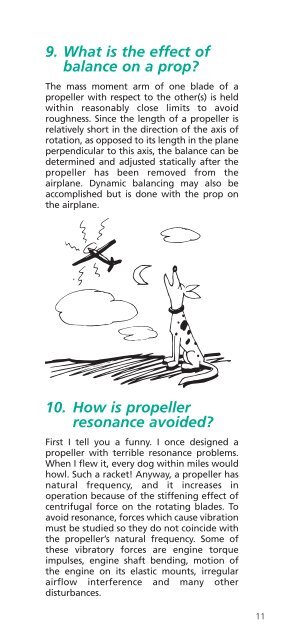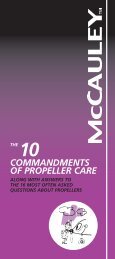propeller performance - McCauley Propeller Systems - Textron
propeller performance - McCauley Propeller Systems - Textron
propeller performance - McCauley Propeller Systems - Textron
Create successful ePaper yourself
Turn your PDF publications into a flip-book with our unique Google optimized e-Paper software.
9. What is the effect of<br />
balance on a prop?<br />
The mass moment arm of one blade of a<br />
<strong>propeller</strong> with respect to the other(s) is held<br />
within reasonably close limits to avoid<br />
roughness. Since the length of a <strong>propeller</strong> is<br />
relatively short in the direction of the axis of<br />
rotation, as opposed to its length in the plane<br />
perpendicular to this axis, the balance can be<br />
determined and adjusted statically after the<br />
<strong>propeller</strong> has been removed from the<br />
airplane. Dynamic balancing may also be<br />
accomplished but is done with the prop on<br />
the airplane.<br />
10. How is <strong>propeller</strong><br />
resonance avoided?<br />
First I tell you a funny. I once designed a<br />
<strong>propeller</strong> with terrible resonance problems.<br />
When I flew it, every dog within miles would<br />
howl. Such a racket! Anyway, a <strong>propeller</strong> has<br />
natural frequency, and it increases in<br />
operation because of the stiffening effect of<br />
centrifugal force on the rotating blades. To<br />
avoid resonance, forces which cause vibration<br />
must be studied so they do not coincide with<br />
the <strong>propeller</strong>’s natural frequency. Some of<br />
these vibratory forces are engine torque<br />
impulses, engine shaft bending, motion of<br />
the engine on its elastic mounts, irregular<br />
airflow interference and many other<br />
disturbances.<br />
11



